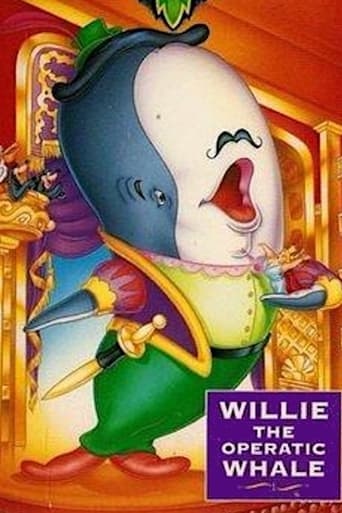Zebrafil
Irwin Graham clearly was writing about every pompous know it all it the music business and I have no doubt the wrote from experience. Making sweet Willie a martyred artist has its point to an adult audience existentially. I am amazed at the positive reviews praising the tragic aspect of the beautifully made but but pitifully sad cartoon. Willie in heaven takes about one percent of the edge off and factually there were so many ways to allow a redemptive ending it amazes me no other ending made it to the screen the Ahab and Moby Dick approach was an early lesson in tragic obsession and there is value in teaching such things but Disney had a way of doing the beauty and the humor so well that one is not ready for the sucker punch of Willie not surviving the harpoon. Graham took his revenge of the music world and inspired me to punch him in the nose someday. So I swore at 5 years of age. There are better methods of creation for kids and teaching them about death. Noble idea badly executed Martyr complex One O one
Atreyu_II
"Willie the Operatic Whale"... my oh my, I have just watched this for the first time in ages. I barely remembered anything from this. This is one of the segments from Walt Disney's "Make Mine Music".While certainly not as good as the little masterpiece "Peter and the Wolf", this one is enjoyable in a different way. The first minutes are a bit weak, but once the whale Willie is introduced, this improves notoriously.This whale's name (Willie) could almost cause some confusion with Willy (the orca from the "Free Willy" movies). But only their names are similar. Similar, not equal. And yes, they are both whales, but this Willie is a sperm whale.Willie himself makes this short so enjoyable. He might be enormous, but he's a nice and friendly whale. In other words, a gentle giant. He doesn't hurt or do anything bad to anyone, he's just a very unusual whale that likes to take advantage of his incredible talent to sing Opera music. He sings very well, especially that delightful Italian song "Figaro" (a song which can also be heard in a great commercial of the Fiat Ritmo). In fact, that's precisely what Willie wishes most: to become an Opera singer... which happens. Willie has more amazing and unbelievable abilities that make him a very special whale. The ending, however, is sad: poor Willie! Whales are certainly majestic and fantastic big animals. They fascinate me. Sadly, they are an endangered species. If this keep going like this, someday there will be no more whales.As for the cartoon, it has generally good artwork, aside in the first minutes before the whale appears. The sceneries, the seagulls and Willie are especially well drawn.
smeyer52-2
I was introduced to opera at 6 years age listening repeatedly to the 78 RPM 3 disk recording of this magnificent Disney production. I never saw the video until I was 40 years old. It is a charming and exciting animation that will captivate young children. I forgot about opera by 9 years age until I accidentally heard the sextet from Lucia di Lammermoor at college and immediately recognized Willie. I fell in love with grand opera all over again at that moment and pushed aside my rock and pop collections.Music from Barber of Seville (Rossini), Lucia di Lammermoor (Donizetti), Pagliacci (Leoncavallo), Mephistofiles (Boito), Tristan und Isolde (Wagener), Martha (Flotow), possibly other I do not recognize.Play it to your children. Wean them with it, and one day they will remember.
Ron Oliver
A Walt Disney Cartoon.Endowed with tremendous vocal powers, WILLIE THE OPERATIC WHALE dreams of leaving his ocean home and becoming a success on the stage of the New York Met.This heart touching little film, originally the closing segment of MAKE MINE MUSIC (1946), is buoyed along by the colorful animation and a prodigious vocal performance by Nelson Eddy who enacts all the roles - young & old, male & female, human & animal. The ending couldn't be better.Walt Disney (1901-1966) was always intrigued by pictures & drawings. As a lad in Marceline, Missouri, he sketched farm animals on scraps of paper; later, as an ambulance driver in France during the First World War, he drew comic figures on the sides of his vehicle. Back in Kansas City, along with artist Ub Iwerks, Walt developed a primitive animation studio that provided animated commercials and tiny cartoons for the local movie theaters. Always the innovator, his ALICE IN CARTOONLAND series broke ground in placing a live figure in a cartoon universe. Business reversals sent Disney & Iwerks to Hollywood in 1923, where Walt's older brother Roy became his lifelong business manager & counselor. When a mildly successful series with Oswald The Lucky Rabbit was snatched away by the distributor, the character of Mickey Mouse sprung into Walt's imagination, ensuring Disney's immortality. The happy arrival of sound technology made Mickey's screen debut, STEAMBOAT WILLIE (1928), a tremendous audience success with its use of synchronized music. The SILLY SYMPHONIES soon appeared, and Walt's growing crew of marvelously talented animators were quickly conquering new territory with full color, illusions of depth and radical advancements in personality development, an arena in which Walt's genius was unbeatable. Mickey's feisty, naughty behavior had captured millions of fans, but he was soon to be joined by other animated companions: temperamental Donald Duck, intellectually-challenged Goofy and energetic Pluto. All this was in preparation for Walt's grandest dream - feature length animated films. Against a blizzard of doomsayers, Walt persevered and over the next decades delighted children of all ages with the adventures of Snow White, Pinocchio, Dumbo, Bambi & Peter Pan. Walt never forgot that his fortunes were all started by a mouse, or that childlike simplicity of message and lots of hard work always pay off.
